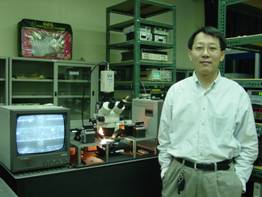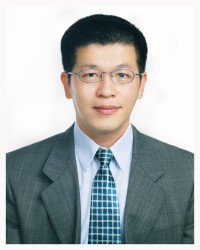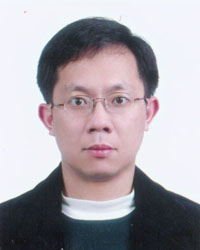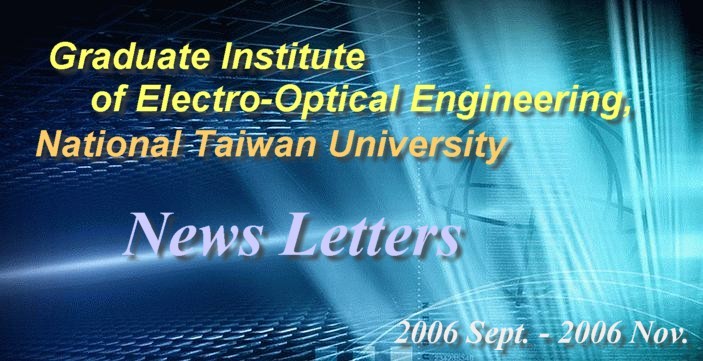
¡@
![]() Congratulations! Professor Chun-Hsiung Chen, Professor Jing-Shown
Wu,
Congratulations! Professor Chun-Hsiung Chen, Professor Jing-Shown
Wu,
Professor Si-Chen Lee and Professor Hung-Chun Chang engaged as Tenured
Distinguished Professors
GIEOE¡¦s Professor Chun-Hsiung Chen, Professor Jing-Shown Wu, Professor Si-Chen Lee, Professor Hung-Chun Chang have been engaged as NTU¡¦s Tenured Distinguished Professors. Congratulations!
![]() Congratulations! Prof.
Chung-Chih Wu, Chih-I
Wu, Jiun-Haw Lee,
Jian-Jang
Congratulations! Prof.
Chung-Chih Wu, Chih-I
Wu, Jiun-Haw Lee,
Jian-Jang
Huang successfully promoted
The applications for promotion of GIEOE¡¦s Associate Professor Chung- Chih Wu and Assistant Professors Chih-I Wu, Jiun-Haw Lee, Jian-Jang Huang have all been approved by NTU¡¦s Faculty Evaluation Committee. Congratulations!
![]() GIEOE
Chairman Yang visits Professor Silvano Donati of Italy¡¦s Pavia
GIEOE
Chairman Yang visits Professor Silvano Donati of Italy¡¦s Pavia
University
GIEOE Chairman Yang attended a seminar in Germany from October 6th through 9th, and used the opportunity to visit Pavia University¡¦s Professor Silvano Donati and his wife Tiziana Tambosso in Milan, Italy. Professor Donati and his wife visited GIEOE from September 2005 to February 2006 for six months, working on collaborative research and teaching the course ¡§Electro-Optical Instrumentation¡¨. The photograph below shows Chairman Yang and Professor and Madame Donati in Milan.
|
|
![]() The Mongolian University of Science and Technology delegation
visits GIEOE
The Mongolian University of Science and Technology delegation
visits GIEOE
(October 31st, 2006)
Prof. Sarantuya Tsedendambyn, a Professor of the Department of Mathematics and the Director of the Center for International Exchange of the Mongolian University of Science and Technology in Ulaanbaatar, along with Prof. Davaassuren Bavuudoj and Prof. Gantogoo Ulziibat visited GIEOE on October 31st. The visitors and Chairman Yang discussed academic exchange and shared ideas. At present, GIEOE hosts one student of Mongolian nationality, Tuvshintugs Damdinsuzen, a graduate of the Mongolian University of Science and Technology.
¡@
¡@
![]() My life at GIEOE, NTU
My life at GIEOE, NTU
Kung-An Lin,
The Sixth President of the Student Association of GIEOE (a Master graduate of year 2006)
I¡¦ve finally graduated; each year¡¦s graduates from GIEOE would sigh deeply. From knowing nothing to finally giving research my all, this was a difficult and painstaking process. Aside from the occasional laboratory class, undergraduate studies rarely provided opportunity for hands-on experiences. Rather, our time was spent wading through textbooks, learning from the knowledge and experience of others. Upon entering the graduate school, we discovered that studying from texts was not enough: progress in research required persistent gathering of information from various sources and ongoing reflection and deliberation. Upon first stepping into the laboratory, we proceed with each experiment step by step under the careful guidance of a senior colleague. The process was ponderous, yet significant. The spirit of research lied in the pursuit of truth. Thus, every step must be undertaken with care; rigorous and exacting standards were a matter of course, yet they also created pressure. However, the most important aspect of research was still the ongoing reflection, which was one of the most valuable aspects of my training as a graduate student. I once relied on senior colleagues and professors, simply following their directives, and ended up in finding that true progress in research required my own drive and initiative. Habitual dependence on others only creates difficulties in research; the problem began within me and only I could provide its solution. I¡¦d like to express my gratitude towards my advisor Prof. Ching-Fuh Lin who, during my years in graduate studies, continuously guided me toward and reminded me of my true goal and purpose. Also, thank you to Chairman C.C. Yang for your guidance and life lessons, and good wishes and best of luck in research to all professors and colleagues.
|
|
| Kung-An Lin (right) with advisor Prof. Ching-Fuh Lin (left) |
¡@
![]() GIEOE and Dept. of MSE Academic Exchange Workshop
GIEOE and Dept. of MSE Academic Exchange Workshop
![]()
August 2nd, 2006
Barry Lam Hall, Rm 201, College of EECS, NTU
In order to promote research collaboration and increase mutual understanding, the first academic exchange workshop of GIEOE (Graduate Institute of Electro-Optical Engineering) and the Department of MSE (Materials Science and Engineering) was held successfully by GIEOE on August 2nd (Wednesday). On the day of the workshop, Dean Huan-Jang Keh, College of Engineering and Dean Soo-Chang Pei, College of EECS (Electrical Engineering and Computer Science) both attended to deliver speeches. Participating academics from the Dept. of MSE include Chairman Wen-Bin Liau, Prof. Po-Cheng Kuo, Prof. Wen-Cheng Wei, Prof. Wei-Hsing Tuan, Prof. Wei-Fang Su, Prof. Chun-Wei Chen, Prof. Hsuen-Li Chen, Prof. Miin-Jang Chen, and Prof. Feng-Yu Tsai. And participating members from GIEOE include Chairman C. C. Yang, Vice Chairman Sheng-Lung Huang, Prof. Zhe-Chuan Feng, Prof. Chee-Wee Liu, Prof. Lung-Han Peng, Prof. Gong-Ru Lin, Prof. Hoang-Yan Lin, Prof. Chih-I Wu, Prof. Jiun-Haw Lee, Prof. Jian-Jang Huang, Prof. Ding-Wei Huang, Prof. Guo-Dung Su, Prof. Yun-Li Li, and Prof. Jui-Che Tsai. During the seven-hour workshop, professors from both academic parties reported on their fields of research and launched lively discussions. Listening to the reports inspired the professors to explore new research interests and future routes of collaboration. For instance, a professor of GIEOE discovered, much to his delight, that an organic thin film, currently purchased at great cost from overseas, can be easily and cheaply supplied by the faculty of the Department of MSE. This conference has opened the channels of communication and cooperation between NTU¡¦s departments/institutes. If collaboration between the participating parties turns out to be successful, in the future GIEOE and the Dept. of MSE will hold more workshops, which will increase the overall competitiveness of NTU.
 |
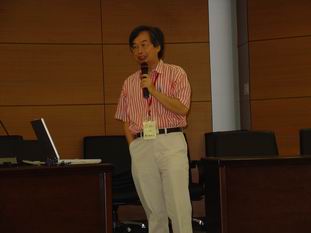 |
|
Dean Huan-Jang Keh, College of Engineering (front left) and Dean Soo-Chang Pei, College of EECS (front right) deliver remarks |
Chairman Wen-Bin Liau, Dept. of MSE address the workshop participants |
 |
 |
|
Chairman C. C. Yang, GIEOE delivers welcoming remarks |
Participating professors report on their research fields (center: Prof. Feng-Yu Tsai of Dept. of MSE) |
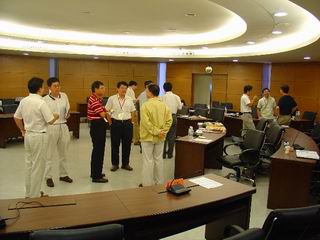 |
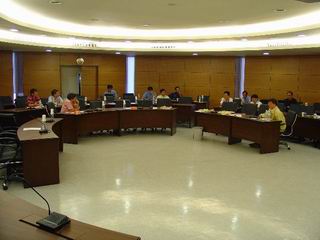 |
| Discussions in progress | Discussions in progress |
¡@
![]() GIEOE Student Association¡¦s
GIEOE Student Association¡¦s
2006 Welcome Party and Mid-Autumn Festival Lunch Social
![]()
September 29th, 2006
Barry Lam Hall, B1, College of EECS, NTU
~ President Chieh-Yu Kang, GIEOE Student Association ~
The annual Mid-Autumn Festival lunch social has always been a major event on every GIEOE student¡¦s calendar. This year, aside from the elegant lunch, live band performance, and generous prizes donated by Chairman Yang and Vice Chairman Huang, there were also T-shirts sporting the GIEOE logo for the first 150 attendees. It was hoped that those who attended would enjoy the festivities.
This year, decorations for the site of the lunch social were designed mainly by GIEOE students Tsu-Chiang Hsu, Yu-Ling Weng, and Meng-Kuei Hsieh. A long strip of black paper laid on the floor was used as a pathway and also served as a place for students and faculty members to sign their names and leave messages. Lighting instruments in the area were covered with translucent colored paper, another creative touch that added atmosphere and ambience to the event.
Branded T-shirts were given away beginning at 12:10 in the afternoon; dispersed among the large and quickly growing crowd, the 150 T-shirts were gone in 20 minutes. Chairman Yang led the opening for the lunch social, explaining the intent behind this year¡¦s event. Lunch and live performances followed.
|
|
|
| The party site, crowded with people | Chairman Yang delivering a speech |
Bands comprised of GIEOE students made up the majority of performers this year. GIEOE student Po-Jui Liao and band members performed two opening songs, written by Po-Jui Liao himself. Kuo-Fen Tseng, Tsu-Pu Lin and fellow band members made up the second group of performers. The climax of the performances came with Prof. Yun-Li Li¡¦s rendition of Jay Chou¡¦s popular ¡§Chi-Li-Hsiang (Common Jasmin Orange)¡¨. Professor Li¡¦s moving singing voice and handsome bearing left everyone with an indelible impression.
|
|
|
| Po-Jui Liao and band members | Kuo-Fen Tseng, Tsu-Pu Lin, etc. |
The day¡¦s entertainment closed with the much-anticipated prize-drawing. Prizes for this year¡¦s lunch social were chiefly provided by Chairman Yang, Vice Chairman Huang, the College of EECS office and the GIEOE office. At the end of the event, everyone left happily with great satisfication.
Lastly, thank you to vice president Yi-Ming Chen of the Student Association, Tsu-Chiang Hsu, Chih-Ling Wu, Pi-Kuei Shih, Yu-Ling Weng, Meng-Kuei Hsieh, Yu-Hsuan Ho, Cheng-Ta Miu, Yu-Ta Wang, Tsu-Pu Lin, Kuo-Fen Tseng, Po-Jui Liao, and their lab colleagues, as well as students of Lab 402, Lab 405, and Barry Lam Hall Lab 511, for all your hard work and dedication that made this event a success.
|
|
|
|
Professor Li singing Jay Chou¡¦s
¡§Chi-Li-Hsiang (Common Jasmin Orange)¡¨ |
Live performances |
¡@
|
|
Professor Prof. Gong-Ru Lin received his B. S. degree of Physics from Soochow University in 1988, M. S. and Ph. D degrees of electro-optical engineering from National Chiao Tung University (NCTU) in 1990 and 1996, respectively. Prior to join National Taiwan University, Prof. Lin has ever joined National Lien Ho College of Technology in 1997 and |
|
Tatung University in 1998 as an Assistant Professor, he became an Associate Professor with National Taipei University of Technology in 2002. He has promoted as a Professor in 2004 with the Institute of Electro-Optical Engineering at National Chiao Tung University. Prof. Lin is the member of Optical Society of America (OSA), the International Society for Optical Engineering (SPIE), the Lasers and Electro-Optics (LEOS) and the Microwave Theory and Techniques (MTT) societies of IEEE. He also joined as the permanent members of the Optical Engineering Society, Physical Society, and CIEE of R. O. C. In particular, he has also served in SPIE as Award Committee (since 2003), Secretary of Taiwan Chapter (since 2004), and Vice Chair of Taiwan Chapter (since 2006). He is also the treasurer (since 2004) and will become Vice Chair (since 2007) of IEEE/LEOS Taipei Chapter. Prof. Lin has conducted several NSC long-term projects and joined the famous research teams as co-PIs for executing excellent national projects funded by Ministry of Education. Prof. Lin has published more than 90 journal papers and 140 conference papers. He was invited as a technical program committee and session chairs in the 2000 International Symposium on Antennas and Propagation (Fukuoka, Japan, 2000), the Asia Pacific Optical Communication Conference (Gwangju, Korea, 2006), and the 2000-2006 Conference on Optics and Phtonics (Taiwan, 2000-2005). He has given invited talks in Asia Pacific Optical Communication Conference (APOC) in 2003 and 2006, and SPIE Photonics Europe 2006, etc. Prof. Lin also served on the international reviewer panel of the Journals of the "Medical Science Monitor" and the "Recent Patents on Engineering", he is also the referee of several journals published by the IEEE/LEOS, OSA, and Elsevier Science. He received three times the researching awards from National Science Council in 1998, 1999, and 2001, and was included in Who¡¦s Who in Science and Engineering, 6th Ed. since 2002 for recognizing his contribution to optical science and engineering. His work has also been recognized by the ultrafast community and awarded the 2000 Tien Jea Bien Young Scholar Prize by the Optical Engineering Society of R. O. C. for outstanding achievement in the field of Photonics by the age of 34. Prof. Lin was elected by the International Biographical Center as the international Scientist of the Year 2002, and promoted as a senior member in the Laser and Electro-Optics (LEOS) society of IEEE since 2004. To date, Prof. Lin just received the Third Best Scientific and Technical Paper Award (with co-authors) from the Far Eastern Y. Z. Hsu Science & Technology Memorial Foundation of R. O. C. in 2004, the Young Scholar Research Award from NCTU in 2005, and the Award of Outstanding Youth Electrical Engineer from SIEE in 2005. Prof. Lin concentrates his research on developing versatile specific synthesizing processes for Si nanostructures and related devices, investigating the physical mechanisms behind the material, electrical, and optical aspects of the Si nanodots, nanopyramids and nanopillars. The targets are implementing Si nanophotonic devices based on quantum confinement effect, and discuss in more detail the origin of the enhancement on radiation/detection, solar energy conversion, and surface plasmonic resonance at blue-green wavelength region. Collaboration with Academia Sinica is initiated on the ab initio atomic potentials based boundary integral Green function for the quantum computation of Si quantum dots. These simulations will be helpful to elucidate the carrier transport and penetration between Si nanocrystals and neighborhood dopants, and to realize the surface plasmonic wave interaction between Si nanostructures and biomoleculars. Several featured researches including ultra-low threshold ICP power PECVD synthesis for Si nanopyramids, CO2 laser based rapid thermal annealing for precipitating Si nanocrystals, rapid self-aggregated metallic nanodot array for SPR or nano-lithographical applications will be introduced in the following sections. On the other hand, Prof. Lin is also interested in fundamental and technical study of fiber laser schemes for potential applications on ultrafast optoelectronic diagnosis, high-speed fiber-optic communications, and biophotonic or biomedical analysis, etc. Over past years, Prof. Lin has constructed several types of continuous-wave and shorted-pulsed Erbium-doped fiber amplifier or semiconductor optical amplifier based fiber ring lasers. In particular, he has theoretically simulated and experimentally established an optical injection mode-locked semiconductor optical amplifier fiber laser system, which exhibits femtosecond pulsewidth after external soliton compression and facilitates high-repetitive low-supermode-noise output. The other milestones of Prof. Lin's works include 40th-oeder rational harmonic mode-locking of EDFL using a FPLD based mode-locker, mutual injection-locked EDFL/EDFL and FPLD link, tipped fiber based low-splicing-loss fusion technology between different fibers, >10GHz backward optical injection induced cross-gain-modulation for mode-locking, etc. In brief, the distinguished researching fields on Si nanophotonics, fiber lasers, and all-optical communication data processing likes are emphasized in his laboratory, which include: A. Femtosecond Mode-Locked Fiber Lasers and Soliton Compressors B. Nanocrystallite Silicon LEDs and Solar Energy Photonics C. All-Optical OC-192 NRZ/RZ Communication Data Format Processing D. Mutually Injection-Locked Laser Diode Based Fiber-Optic Communication Link E. Millimeter-wave Optoelectronic Phase-Locked Loops and Phase Shifters F. GaAs:As+ Ultrafast Photoconductive Switches and Time-Resolved Optical Diagnostics |
|
¡@
|
Professor ¡P BS: Peking University , China ¡P MS: Peking University , China ¡P PhD: University of Pittsburgh ¡P Address: BL-417, Graduate Institute of Electro-Optical Engineering and Department of Electrical Engineering, National Taiwan University, Taipei 106, Taiwan, ROC ¡P Phone: +886-2-3366-3543 ¡P Fax: +886-2-23677467 ¡P E-mail: zcfeng@cc.ee.ntu.edu.tw |
|
|||||||||||||||||||||||||||||||||||
|
¡@ Working Experience¡G 1. Emory University (1988-1992) 2. National University of Singapore (1992-1994) 3. Georgia Tech (1995) 4. Emcore Company (1995-1997) 5. Institute of Materials Research & Engineering, Singapore (1998-2001) 6. Axcel Photonics (2001-2002) 7. Georgia Tech (2002-2003) Since Sept 2003, Feng has joined National Taiwan University as a full professor at Department of Electrical Engineering & Graduate Institute of Electro-Optical Engineering, focusing on MOCVD and investigation of III-Nitrides, SiC, III-V, oxides and nano-structural materials/devices. Feng has a wide range of academic interests in the field of interdisciplinary analysis on advanced electronic materials and devices by the combination of optical, electrical, structural, surface, nuclear and other techniques. Feng has edited and published six review books on advanced compound semiconductors and microstructures, porous Si, SiC and III-Nitride semiconductor materials with one more currently in editing on III-Nitride devices and Nano-engineering, and published >300 scientific/technical papers with more than half selected by Science Citation Index and cited >1250 times. He has been symposium organizer and invited speaker in different international conferences and universities, a reviewer of Physics Review Letters and Physics Review B as well as several other international journals. He has served as the Chief Guest editors for two special issues at journals of Thin Solid Films and Surface & Coatings Technology. He has been visiting/Guest professors at Huazhong University of Science & Technology, Nankai University and Tianjin Normal University. He is currently a member of International Organizing Committee of Asian Conferences on Chemical Vapor Deposition, and Board of Directors, Taiwan Association for Coating and Thin Film Technology (TACT). Major Research Areas: Research and Development (R&D) on wide gap semiconductors have attracted intense attention and investment in the world range in recent years. GaN-based and other materials and devices, such as blue-visible light emitting diode (LED) and laser diode (LD), fast and power electronics, have formed new industries, in particular in Taiwan . In the past few years, Taiwan industry has grown from 0 to 80% of the world¡¦s InGaAlP green-red high-brightness LED production. In 2003, Taiwan, China & Korea grew 700% in GaN volume & now supply 40% of worldwide market share. Asia produces almost all lasers for CD & DVD. Blue-laser DVD formats are happening now. All these materials are mainly produced by metalorganic chemical vapor deposition (MOCVD) technology. Further R&D will promote quickly the white solid state lighting and lead to a new era of human lighting world which has been based upon Edison ¡¦s invention of electric light-bulb more than one century ago. Current Research¡G Current research will focus more on wide gap semiconductor MOCVD growth, inter disciplinary materials investigation and nano-scale device development. They are hoping to make their contributions for the above revolutionary conversion in compound semiconductor fields, for example, to explore different growth methods, to study the growth associated defects and problems, to penetrate the physical mechanisms and understanding of optical and structural experiment findings, to find the way to control these defects during the growth procedure, and to achieve the high quality of III-Nitrides and other epitaxial materials. All the research works including students will perform in the good scientific and technological environments through our self-efforts and various collaborations, in EOE and NTU, in particular with industries and international collaborators. Graduates would have good trainings in the basic concepts, theory and experiments on wide gap semiconductors, MOCVD epitaxy and various characterization/processing technologies, abilities in national and international collaborations. Research Results¡G Temperature-dependent photoluminescence (T-PL)
The fitting result was also plotted by a red line. From the fitting, A and T0 are calculated to be 0.106 and 52.968 K, respectively. Raman spectra: normal and cross-section incidence Raman scattering of a MOCVD undoped GaN/sapphire, excited by 514.5 nm in the back-scattering geometry at RT.
Raman measurements on Cross-section of GaN thin films Comparative m-Raman spectra of MOCVD-grown GaN/sapphire.
High resolution X-ray Diffraction (HR-XRD)
Well/barrier width and average indium composition were estimated to be around 2.5/12.75 nm and 23.5 % by using Philips X¡¦pert Epitaxy and Smooth fit. High resolution Transmission Electron Microscopy (HR-TEM)
High-angle annular dark field scanning transmission electron microscopy (HAADF-STEM) For another MQW LED:
Proposals funded¡G
Publication¡G More than 300 papers were published, including 6 books:
Main Publication¡G 1. Zhe Chuan FENG, ¡§III-Nitride Semiconductor Materials,¡¨ Imperia College Press, UK, 430 pages, Mar. 2006 2. Zhe Chuan FENG, ¡§SiC Power Materials ¡V Devices and Applications,¡¨ Springer, Berlin, 445 pages, 2004 3. Zhe Chuan FENG and Jian H. ZHAO, ¡§Silicon Carbide: Materials, Processings and Devices,¡¨ Taylor & Francis Books, Inc., New York, 389 pages, 2003 4. G. Xu and Z.C. Feng,, ¡§Internal atomic distortion and layer roughness of epitaxial SiC thin films studied by short wavelength x-ray diffraction,¡¨ Phys. Rev. Lett., 84, 1926-1929, 2000 5. W. Chang, J. Lin, W. Zhou, S.J. Chua & Z.C. Feng, ¡§Photoluminescence and photoelectron spectroscopy analysis of InGaAsN grown by metalorganic chemical vapor deposition¡¨, Appl. Phys. Lett. 79, 4497-4499 (2001). 6. Z.C. Feng, ¡§Micro-Raman scattering and micro-photoluminescence of GaN thin films grown on sapphire by metalorganic chemical vapor deposition¡¨, Optical Engineering 41, 2022-2031 (2002). 7. J.H. Zhao, P. Alexandrov, L. Fursin, Z.C. Feng & M. Weiner, ¡§High performance 1500 V 4H-SiC junction barrier Schottky diodes¡¨, Electronics Lett. 38, 1389-90 (2002). 8. Z.C. Feng, J.H. Chen, J. Zhao, T.R. Yang & A. Erbil, ¡§Raman scattering of ferroelectric lead lanthanum titanate thin films grown on fused quartz by metalorganic chemical vapor deposition¡¨, Ceramics International 30, 1561-1564 (2004). 9. Z.C. Feng, W. Liu, S.J. Chua, J.H. Chen, C.C. Yang, W. Lu & W.E. Collins, ¡§Recombination Mechanism of InGaN Multiple Quantum Wells Grown by Metalorganic Chemical Vapor Deposition¡¨, Phys. Stat. Solidi (c), 2, 2377-2380 (2005). 10. Z.C. Feng , H.C. Lin, W. Lu, W.E. Collins & I. Ferguson, ¡§Surface and optical properties of AlGaInP Films Grown on GaAs by Metalorganic Chemical Vapor Deposition¡¨, Thin Solid Films 498, 167-173 (2006). |
||||||||||||||||||||||||||||||||||||
¡@
|
|
Assistant Professor Professor Chiou was born in Taoyuan, Taiwan. He received the B.S. and PhD degrees from National Taiwan University, Taipei, in 1992, 1998, respectively, both in electrical engineering. His PhD dissertation was on the numerical techniques of guided wave modeling. From 1999 to 2000, he was with the Taiwan Semiconductor Manufacturing Company (TSMC), Hsin-Chu, Taiwan, where his interests were on the plasma enhanced chemical vapor deposition (PECVD) of dielectric and metallic materials, |
|
including silicon dioxide, silicon nitride, aluminum, and tungsten. He developed a highly compressive stress silicon oxide film to compensate the highly tensile stress of normal one, which cured the crack problem in products. He earned best process engineer award in 2000 for such contribution. From 2001 to 2003, he was with the RSoft Design Group, New York, where his research interests were on the modeling of simulation techniques and developing of photonic computer-aided-design tools. He was involved with the simulation engines of BeamPROP (based on beam propagation method) and FullWAVE (based on finitie-difference time domain method). In February, 2003, He joined the faculty of the Department of Electrical Engineering and Graduate Insititute of Electro-Optical Engineering, National Taiwan University, Taipei, Taiwan. His research interests are modeling and computer aided design (CAD) of optoelectronics, which includes 1. Light extraction in display devices; 2. Optical properties and applications of photonic crystals; 3. Negative refraction meta-materials; 4. Near-field optics of nano structures; 5. Analysis and design of integrated optical devices and systems; 6. Analysis and design of optical communication devices and systems; 7. Improvement and development of novel modeling techniques. |
|
¡@
|
Group of Organic Optoelectronics and Displays Research areas: organic light-emitting devices (OLEDs), display and lighting technologies, organic semiconductors and optoelectronics |
|
I. Overview
Our research interests are mainly in organic semiconducting and electro-optical materials and devices. We perform studies covering both fundamental science of organic materials/devices and innovation in technologies and applications, including: high-efficiency and high-image-quality OLEDs for displays and lighting; device/display optics; stimulated emission/lasing; organic photoresponsive devices/photodetectors; charge transport in organic semiconductors; photophysics/optical properties of condensed organic materials; time-resolved and polarized spectroscopy; morphologies/physical phases/phase transitions in condensed organic materials (e.g. amorphous, liquid crystals, aggregates, isotropic/anisotropic phases etc.); correlation of molecular structures with physical and electro-optical properties.
Within the past five years, we published nearly 50 high-impact SCI papers in top journals of related fields. Some research results set records in organic semiconductors and devices and had been featured by the Journal cover story (Applied Physics Letters) and news reports of scientific magazines (SPIE OE Magazine, Laser Focus World, Photonics Spectra (two times), ACS Heart Cut etc.).
II. Research topics and achievements in recent years
II.1 OLED display/lighting devices and technologies
Works in this area mainly cover high-efficiency and high-image-quality OLED devices and technologies for displays and lighting, device/display optics, and integration technologies etc. Research topics and achievements in these areas in recent years include:
(1) Electromagnetic modeling organic light-emitting structures and devices
(2) High-contrast top-emitting AMOLED (active-matrix OLED) display technology
(3) Microcavity OLEDs
(4) Top-emitting OLEDs
(5) Inverted (top-emitting) OLEDs
(6) Highly efficient Tandem OLED
(7) Microcavity tandem OLEDs
(8) Second-antinode OLED
(9) Various phospohrescent OLEDs
(10) Efficient White-emitting OLEDs
(11) Efficient non-doped UV OLEDs
(12) EfficientNon-doped deep blue OLEDs
(13) High-brightness blue OLEDs
(14) Two-color, full-color and patterned Programmable OLEDs
(15) Fuzzy-junction OLEDs
(16) FS-D2T2, Finite-source dye-diffusion thermal transfer for doping and color integration
(17) Graded-doping OLED
(18) Solvent-assisted dye-diffusion thermal transfer
|
|
|
Fig. 1. Various OLEDs developed by our Lab. |
¡@
|
|
|
Fig. 2. Programmable OLEDs developed by our lab were featured by the cover story of Applied Physics Letters, and news highlights in Laser Focus World and SPIE OE Magazine. |
|
|
|
Fig. 3. High-contrast top-emitting AMOLED display technology developed by our lab was highlighted in news report of Photonics Spectra. |
¡@
|
|
|
Fig. 4. News reports in Photonics Spectra featured our development work on Electromagnetic modeling of OLED, and high optical-efficiency OLED technologies such as Second-antinode OLE and 200-cd/A Microcavity Tandem OLED. |
II.2 Charge transport in organic semiconductors
Works in this area are mainly dedicated to fundamental studies of charge transport in organic semiconductors. Research topics and achievements of this area in recent years include:
(1) Time-of-flight mobility measurement techniques
(2) Studies of electron-transport and bipolar transport materials and mechanisms
(3) Correlation of charge-transport properties and molecular structures
(4) Correlation of charge-transport and molecular electronic structures
(5) Investigation of intermolecular electron transport by quantum calculation
(6) Correlation of charge transport, thin-film morphology, and molecular assembly
(7) Studies of charge transport in molecularly doped polymer systems - for organic photoconductor (OPC).
|
|
|
Fig. 5 Quantum calculation of molecular electronic structures and properties. |
¡@
|
|
|
Fig. 6. ACS Heart Cut Weekly highlighted our work on new organic semiconductors. |
II.3 Optical properties and photophysics of organic semiconductors
Works in this area are mainly to study optical properties and photophysics of organic semiconductors using various spectroscopic techniques and time-resolved spectroscopy. Research topics and achievements of this area in recent years include:
(1) Photoluminescence and photoluminescence excitation spectroscopy
(2) Time-resolved spectroscopy
(3) Investigating properties of excited-state and photophysical properties/mechanisms by quantum calculation
(4) Polarized spectroscopy
(5) Photoresponse spectroscopy
(6) Optical anisotropy in organic semiconductors and their applications
(7) Stimulated emission of organic semiconductors and wavelength tuning techniques
(8) Studies of time-resolved spectroscopy and photophysics of organic optoelectronics materials: In the past few years, we constructed a time-resolved spectroscopic system with large tempral dynamic range and high flexibility for studying various carrier and excited-state dynamics of organic optoelectronic/semiconductor materials and devices and for obtaining understanding of various mechanisms and characteristics. Using such tools, we have studied various topics, such as: (1) time-resolved fluorescence spectra and lifetimes, time-resolved phosphorescence spectra and lifetimes of phosphorescent hosts and dopants, quenching mechanisms etc. that are useful information for device studies and designs; (2) dynamics and lifetimes of charge-transfer states in organic photoresponsive materials and devices; (3) microcavity electrodynamics and photophysics in microcavity organic light-emitting structures (for verification with our theoretical studies);
|
|
|
Fig. 7 Molecular reorientation in organic semiconductors and applications for tunable stimulated emission. |
II.4 Studies and manipulation of physical phases and microscopic morphologies of organic semiconductors
Works of this area are mainly to study various microscopic phases and morphologies of organic semiconductors with various spectroscopy and microscopy techniques, and their manipulation/control. Research topics and achievements of this area in recent years include:
(1) Exploring various microscopic physical phases and morphologies and their transitions/manipulations, such as crystal phase, amorphous glass phase, various liquid crystal phases, liquid crystal glass phases, isotropic and anisotropic condensed phases, nano-aggregates etc.;
(2) Exploring optical, electrical, physical properties and applications of various microscopic phases and morphologies of organic semiconductors;
(3) Investigating molecular self-assembly of organic semiconductors for enhancing various optical and electronic performances of organic semiconductors and devices;
|
|
|
Fig. 8 In-situ observation of guided molecular assembly. |
II.5 Organic sensing devices
Works of this area are mainly to study the response (in terms of electrical, optical, and physical properties) of organic semiconductors to light and various ambient chemicals, for applications in organic sensing devices. Research topics and achievements of this area in recent years include:
(1) High-efficiency organic photodetectors: Using various spectroscopic techniques, we investigated the donor-acceptor electron transfer phenomena in organic semiconductors. For instance, we have developed highly efficient organic visible-blind UV photodetectors with quantum efficiencies up to 80% (similar to that of GaN UV photodetectors) and covering the complete UV-A wavelength range, that may find applications in biomedical, environmental and scientific purposes.
(2) Organic chemical sensors: The electrical, optical and physical properties of many organic semiconductors are influenced by the ambient condition. Making use of such characteristics, we worked on sensitive chemical sensors.
|
|
|
Fig. 9 Prolonged donor-acceptor charge-transfer states and applications in highly efficient organic visible-blind UV photodetectors. |
II.6 Emerging thin-film transistor technologies
(1) Organic light-emitting transistors: we developed efficient organic light-emitting transistors utilizing organic semiconductors with bipolar carrier-transport properties and efficient emission.
(2) Transparent thin-film transistors: We developed fully transparent thin-film transistors using wide-gap semiconductors such as ZnO and other related oxide semiconductors, for applications in enhancing aperture ratios, transmission, and efficiencies of displays.
|
|
|
Fig. 10 Photos of transparent TFT and light-emitting TFTs. |
III. Future prospects
The research projects and directions of our lab currently and in next few years include the following:
(1) Interdisciplinary display project: high-performance active-matrix OLED display technologies
This project is mainly to develop key materials, devices and integration technologies for high-performance (high efficiency, high contrast, high color saturation and large color gamut etc.) active matrix OLED displays.
(2) Interdisciplinary energy and environment project: High-performance OLED lighting project
In collaboration with several other professors in NTU GIEOE, the purpose of this project is to key materials, devices, and integration technologies for high-performance OLED lighting. The topics include high-efficiency phosphorescent OLED materials, high-efficiency OLED lighting devices and related device technologies, critical interface and contact techniques in OLED lighting devices, and optical extraction/enhancement techniques for OLED lighting devices.
(3) National project on nanoscience and nanotechnology: Manipulation of intermolecular electronic interaction
and their device applications
In this project, we will investigate ordered and nanostructured organic materials with molecular self-assembly for largely enhancing electrical, optical and physical properties of organic optoelectronic materials and semiconductors and for application in highly functional and high-performance organic optoelectronic devices such as organic solar cells, organic transistors and chemical sensors etc.
¡@
|
Four directions in Prof. Wu's group: ¡½ Interfaces of organic light emitting diodes ¡½ Work function engineering of metal gate materials by interfacial treatment ¡½ Investigations of anode materials of GaN light emitting diodes ¡½ Behavior discussions of carriers injection from electrode to organic layers |
|
Topic 1¡GInterfaces of organic light emitting diodes
|
|
Topic 2¡GWork function engineering of metal gate materials by interfacial treatment
Our goal is finding a solution to tune the work function on metallic materials
|
|
We tried to use O2 plasma to adhere some charged particles on SiO2 surface
This is one of our experiment of tuning work function,
In this case WF increases by 0.3 eV
Topic 3¡GInvestigations of anode materials of GaN light emitting diodes
¡½ We have found that Ga-doped ZnO and Mo-doped In2O3 semiconductors can form ohmics contact to p-GaN without using Ni/Au as an interlayer. In particular, IMO thin films, with a low specific contact resistance(to p-GaN ), are the best candidates.
|
¡½ The analyses of Secondary ion mass spectroscopy (SIMS) and X-ray photoemission spectroscopy (XPS) indicates that Ga atoms out-diffuse, resulting in a decrease in contact resistance. ¡@ |
|
Topic 4¡GBehavior discussions of carriers injection from electrode to organic layers
¡½ OLED is considered as the next promising candidate to be used in displays because¡K
Flexible substrate, low power consumption, self-emitting, high color contrast, high color saturation, and
broad view angle.
¡½ Why OLED has not yet paralleled LCD?
Low luminescence efficiency, lifetime and stability.
¡½ One solution to enhance luminescence efficiency is to increase carrier injection rate.
¡½ How to Investigate carrier injection across metal-organic interfaces?
1st step: Discuss the injection effect from different kinds of cathodes and measure the V-T curve
2nd step: Fitting, and predicting I-V curve
3rd step: Modeling the hetero-junction
|
|
| ¡@ |
|
|
¡@
|
Display Device Laboratory Research Topics of Prof. Lee: Organic Light-emitting Device, Display Technologies |
|
Main research topics of the display device laboratory focus on the flat panel display technologies, especially in organic light-emitting device (OLED), which includes its design, fabrication, and measurements. By investigating the optical, electrical, and material characteristics, a high quality display device can be obtained.
Previous research topics for Jiun-Haw Lee includes: (1) improve the lifetime and efficiency of OLED, (2) mobility measurement of organic materials, (3) polymer OLED design and fabrication, (4) optical simulation of OLED, (5) electrical simulation of OLED, (6) contrast ratio improvement of OLED, (7) mixing layer OLED design and fabrication, and (8) OLED for lighting.
In recent years, the research topics also include: (1) to fabricate long lifetime and high efficiency OLED for display and lighting, (2) to develop organic electronics and opto-electronics devices for energy and resource technology and radio frequency identification, and (3) integrated miniature organic and inorganic device for bio-sensor.
¡@
Please send any comment to eoe5@cc.ee.ntu.edu.tw
Copyright
Graduate Institute of Electro-Optical Engineering, National Taiwan University
